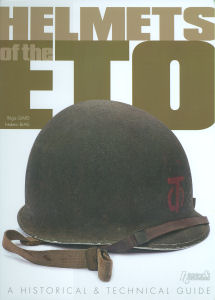
Helmets of the ETO Book Review
By Michael Benolkin
| Date of Review | June 2008 | Title | Helmets of the ETO |
|---|---|---|---|
| Author | Regis Giard and Frederic Blais | Publisher | Histoire & Collections Publications |
| Published | 2007 | ISBN | 978-2-35250-062-9 |
| Format | 216 pages, hardbound | MSRP (USD) | $64.95 |
Review
You might wonder what sort of book would take 216 pages to describe the US M1 helmet used by American and allied forces in the European Theater of Operations (ETO). While the authors do provide some great coverage of the history, evolution, and details of the 'steel pot' and liner, this book is more of a forensic look at World War II from the perspective of over 120 helmets that are presented in these pages.
You've seen these helmets in movies and documentaries how this standard helmet will vary in appearance through the use of markings, camouflage aids, unit/service markings, rank, etc. The authors provide over 700 photos and diagrams of these helmets to provide a snapshot out of time.
Take for example a helmet that bears two bars to signify the rank of Captain. On closer examination, the second bar is brighter than the first, showing that it was a field promotion. The markings on the helmet liner shell also reflect the Captain's bars and also a cross fashioned from tape indicating that the individual was assigned to a medical unit.
Many of the helmet straps bear the names of the owners, and many of them survived the war. Each of these provide a look at a time when each of these men were in the thick of it before rotating back to the rear. Other helmets bear the signs of snipers and either those that were lucky or those that didn't make it. Many of these were found buried in fields and elsewhere around Europe over the years following the war.
This forensic look at history one helmet at a time will be of interest to any World War II historian, and will also be an excellent resource for World War II figure modelers that are missing out on some very distincitve details that were applied in the theater.
My sincere thanks to Casemate Publishing for this review sample!







